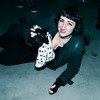
Advertisement
Genesis P-Orridge: It was 1993 in New York. One weekend, we were out with Debbie Harry and Chris Stein, very high on pure pharmaceutical ecstasy for three days. We were staying with Terence Sellers, the writer. Terence was a dominatrix. We were back at Terence’s place and went to the dungeon with the torture table and all the instruments.We laid in the death posture with a white sheet over us and fell fast asleep. The noise of people in the next room woke us up. It was where the dominatrices would sit and make appointments. There was this beautiful six-foot-tall woman in heels wearing a 1960s outfit with a Brian Jones haircut. We just thought, “Wow, who is that?”As she was walking back and forth, she was undressing and putting on fetish clothing. What a great way to wake up! We said out loud: “Dear Universe, if we could be with that woman, that’s all we want for the rest of my life.”
Advertisement
Really, it’s a journal. All the images are taken from life or objects we had lying around. In the art world, sentimentality and intimacy and the emotive side of lives are considered very uncool. There’s nervousness around intimacy.But we don’t see any separation between the life of an artist and what they produce. All the great artists illustrate their approach to life in the work they make. To us, that’s what art should always be—a spiritual quest. Life and art are inseparable. In old Native America, separation is death. They don’t have a word for death, they use the word separation.

Because our work was based on our lives, we were dedicated to melding our lives together, the pandrogyne—or two becoming one. By mirroring each other, we became one. Consciousness, passion, intimacy, and identity are important in a world that has become so cynical and addicting to consuming.Will show be lit with candles?
One part will be—the transgendered sacred heart. It was originally a collage of Polaroids with a Catholic prayer card of Jesus looking feminized. One of the photos was taken by Lady Jaye after our first breast implants. I had a Jackson-Pratt pump in my new breasts that sucks out excess blood from the surgery to get rid of blood clots. In the photo, there was this distorted yellow light like a halo. It looks like a sacred heart.
Advertisement
Polariods are a chemical reaction of light with liquid. That’s far more alchemical than digital technology. They’re all unique—they can’t be repeated. Once in a while, you take a Polaroid and think, That was perfect. Then we'd write "Perfect" at the bottom. We were always thinking they could become a book called Perfect.

If you look carefully where the lines are in the mirrors, half is me and half is Jaye. That becomes Pandrogeny. She is pinching my nipple which is a medieval reference. Through those mirrors we see something more clearly than what we didn’t expect. It’s always important to leave in the element of random chance.Do you have any favorite pieces in the show?
Blood Bunny, a sculpture about ten inches high. It was a carved wooden rabbit—just a piece of wood we found in Tijuana.We went through a phase exploring other dimensions with ketamine. We would get tape recorders, Polaroid cameras, notebooks, and then retrieve information to document. Since the ketamine was injected into the muscle, it would bleed. Instead of wiping the blood off with a rag or tissue, we would rub it into the rabbit.
Advertisement

An ultra-conservative right wing group released an open letter to the media saying we were "homo fascists," whatever that is. They didn’t think we should be allowed to spread our propaganda to the youth of Russia. The media didn’t fall for it. It shows you there’s an undercurrent of fear and paranoia. It happens everywhere.We’ve had troubles with establishments and authorities in some places. They wouldn’t be angry with us if we weren’t doing something that threatened or destabilized them. We don’t want trouble but we’ll say what we believe. It was great to share our message with thousands of young Russians. After we found out what happened, we made a little speech about dogma, bureaucracy, and that our message is love. “Big love,” as me and Lady Jaye would call it.Exhibition at Summerhall as part of the Edinburgh Art Festival is open from July 31 until August 31. Check their website for the full program.Follow Nadja on Twitter.
